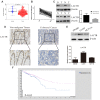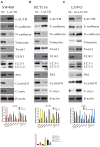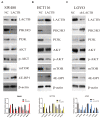LACTB Regulates PIK3R3 to Promote Autophagy and Inhibit EMT and Proliferation Through the PI3K/AKT/mTOR Signaling Pathway in Colorectal Cancer
- PMID: 32636680
- PMCID: PMC7335311
- DOI: 10.2147/CMAR.S250661
LACTB Regulates PIK3R3 to Promote Autophagy and Inhibit EMT and Proliferation Through the PI3K/AKT/mTOR Signaling Pathway in Colorectal Cancer
Abstract
Background: Colorectal cancer (CRC) is one of the most common aggressive malignancies. LACTB functions as a tumor suppressor, and previous findings have demonstrated that LACTB can inhibit epithelial-to-mesenchymal transition (EMT) and proliferation of breast cancer and CRC cells. However, few studies have investigated the roles of LACTB in autophagy and proliferation in CRC. The current study aimed to identify the roles of LACTB in EMT and proliferation associated with autophagy in CRC and to elucidate the probable molecular mechanisms through which LACTB are involved in these processes.
Materials and methods: Transwell invasion, MTT, transmission electron microscopy, RNA-seq, immunoprecipitation, immunohistochemistry and Western blotting assays were performed to evaluate the migratory, invasive, proliferative and autophagic abilities of CRC cells, and the levels of active molecules involved in PI3K/AKT signaling were examined through Western blotting analysis. In addition, the in vivo function of LACTB was assessed using a tumor xenograft model.
Results: Weaker LACTB expression was found in CRC tissue samples than in nonmalignant tissue samples, and LACTB inhibited cell invasion, migration, and proliferation by promoting autophagy in vitro. Furthermore, the regulatory effects of LACTB on autophagy and EMT were partially attributed to the PI3K/AKT signaling pathway. The in vivo results also showed that LACTB modulated CRC tumorigenesis.
Conclusion: LACTB can regulate the activity of PIK3R3 to influence the level of PI3K, and it also promotes autophagy and inhibits EMT and proliferation in part through the PI3K/AKT/mTOR signaling pathway.
Keywords: EMT; LACTB; PIK3R3; autophagy; colorectal cancer; proliferation.
© 2020 Xu et al.
Conflict of interest statement
The authors declare that they have no competing interests.
Figures











Similar articles
-
FAT4 regulates the EMT and autophagy in colorectal cancer cells in part via the PI3K-AKT signaling axis.J Exp Clin Cancer Res. 2019 Mar 4;38(1):112. doi: 10.1186/s13046-019-1043-0. J Exp Clin Cancer Res. 2019. PMID: 30832706 Free PMC article.
-
KLHL22 Regulates the EMT and Proliferation in Colorectal Cancer Cells in Part via the Wnt/β-Catenin Signaling Pathway.Cancer Manag Res. 2020 May 27;12:3981-3993. doi: 10.2147/CMAR.S252232. eCollection 2020. Cancer Manag Res. 2020. PMID: 32547233 Free PMC article.
-
KIFC3 Promotes Proliferation, Migration, and Invasion in Colorectal Cancer via PI3K/AKT/mTOR Signaling Pathway.Front Genet. 2022 Jun 22;13:848926. doi: 10.3389/fgene.2022.848926. eCollection 2022. Front Genet. 2022. PMID: 35812733 Free PMC article.
-
The Pivotal Role of LACTB in the Process of Cancer Development.Int J Mol Sci. 2025 Feb 1;26(3):1279. doi: 10.3390/ijms26031279. Int J Mol Sci. 2025. PMID: 39941048 Free PMC article. Review.
-
Autophagy: A Versatile Player in the Progression of Colorectal Cancer and Drug Resistance.Front Oncol. 2022 Jul 14;12:924290. doi: 10.3389/fonc.2022.924290. eCollection 2022. Front Oncol. 2022. PMID: 35912261 Free PMC article. Review.
Cited by
-
A study on the potential role of autophagy-related protein 10 as a biomarker for ulcerative colitis.Physiol Rep. 2021 Apr;9(7):e14825. doi: 10.14814/phy2.14825. Physiol Rep. 2021. PMID: 33904657 Free PMC article.
-
Regulatory effects of lncRNAs and miRNAs on the crosstalk between autophagy and EMT in cancer: a new era for cancer treatment.J Cancer Res Clin Oncol. 2022 Mar;148(3):547-564. doi: 10.1007/s00432-021-03892-0. Epub 2022 Jan 27. J Cancer Res Clin Oncol. 2022. PMID: 35083552 Free PMC article. Review.
-
LACTB exerts tumor suppressor properties in epithelial ovarian cancer through regulation of Slug.Life Sci Alliance. 2022 Nov 14;6(1):e202201510. doi: 10.26508/lsa.202201510. Print 2023 Jan. Life Sci Alliance. 2022. PMID: 36375842 Free PMC article.
-
Unveiling the Function of the Mitochondrial Filament-Forming Protein LACTB in Lipid Metabolism and Cancer.Cells. 2022 May 20;11(10):1703. doi: 10.3390/cells11101703. Cells. 2022. PMID: 35626737 Free PMC article. Review.
-
CircRNA_0000392 promotes colorectal cancer progression through the miR-193a-5p/PIK3R3/AKT axis.J Exp Clin Cancer Res. 2020 Dec 14;39(1):283. doi: 10.1186/s13046-020-01799-1. J Exp Clin Cancer Res. 2020. PMID: 33317596 Free PMC article.
References
-
- Kahi CJ, Boland CR, Dominitz JA, et al. United states multi-society task force on colorectal, colonoscopy surveillance after colorectal cancer resection: recommendations of the us multi-society task force on colorectal cancer. Gastroenterology. 2016;150(3):758–768.e711. doi:10.1053/j.gastro.2016.01.001 - DOI - PubMed
LinkOut - more resources
Full Text Sources
Miscellaneous

